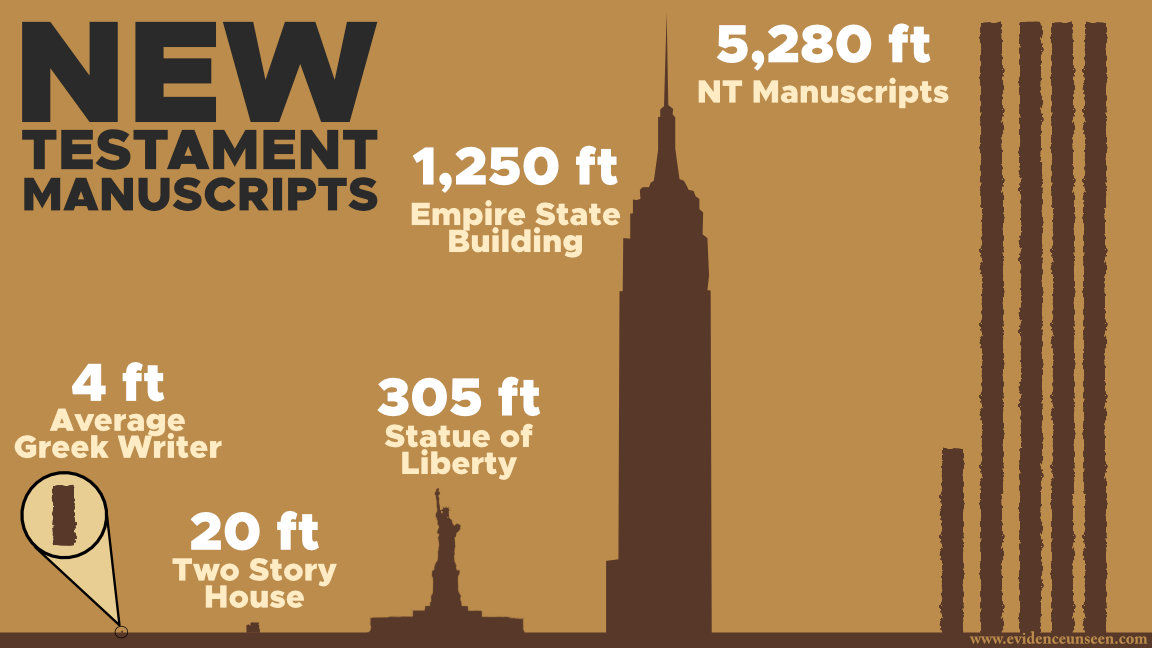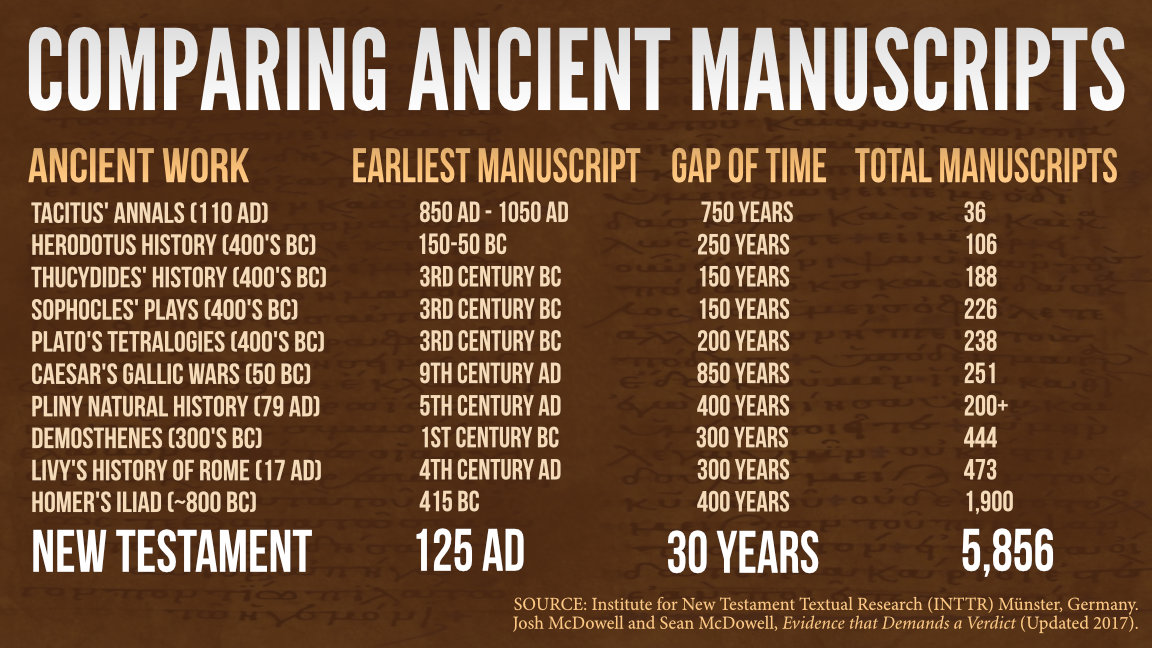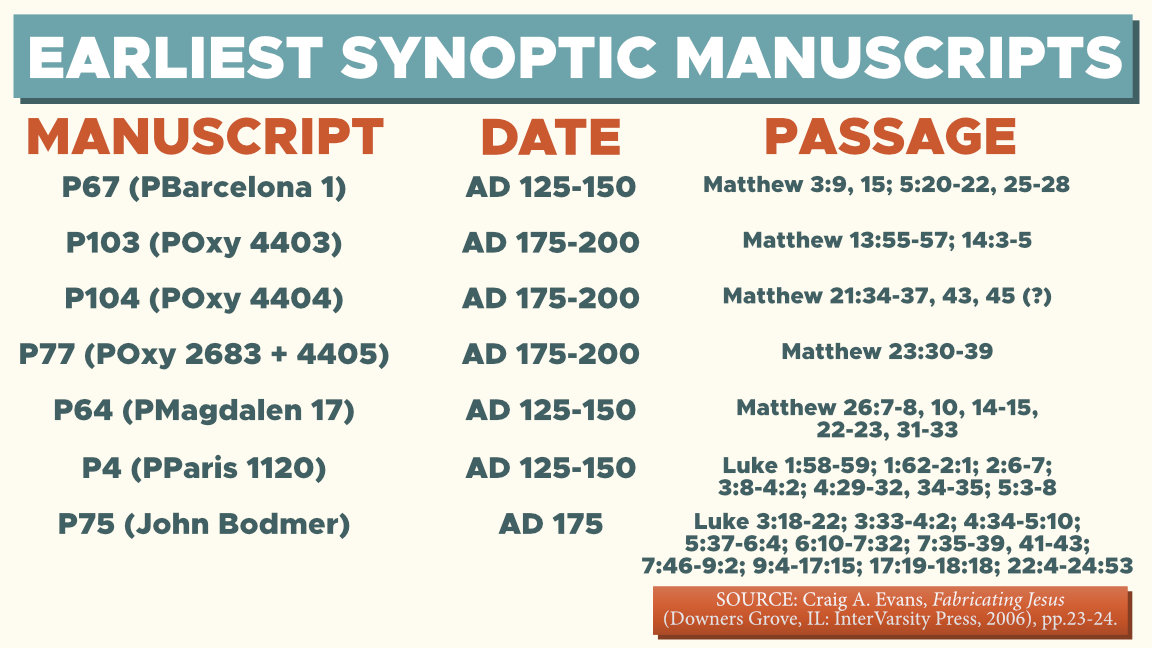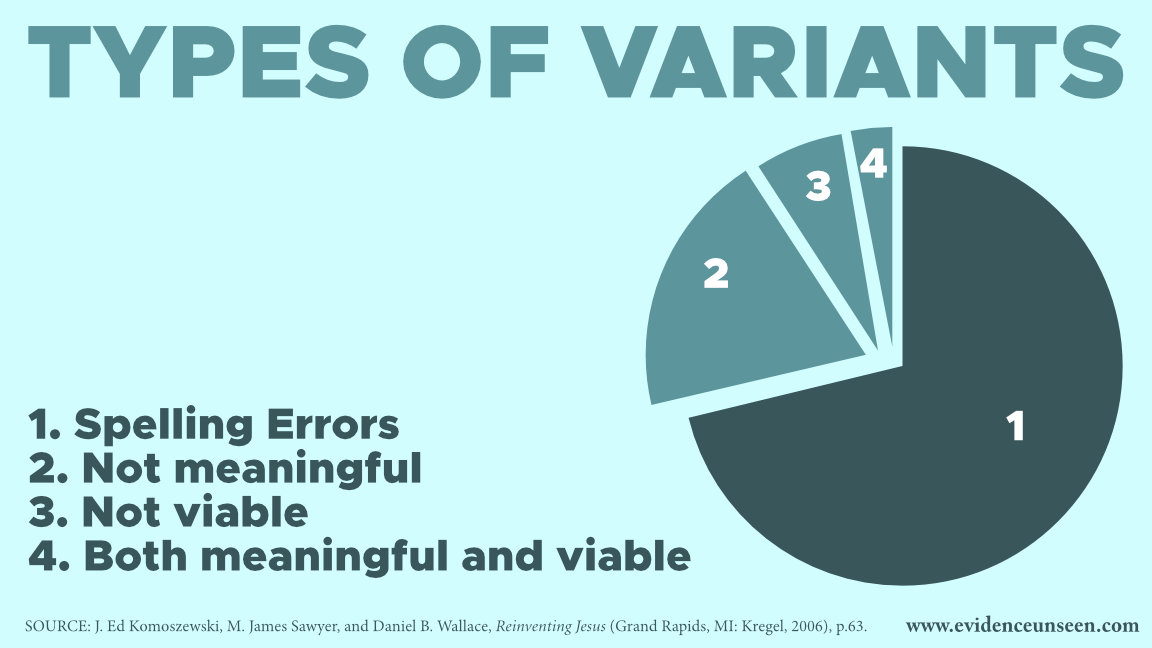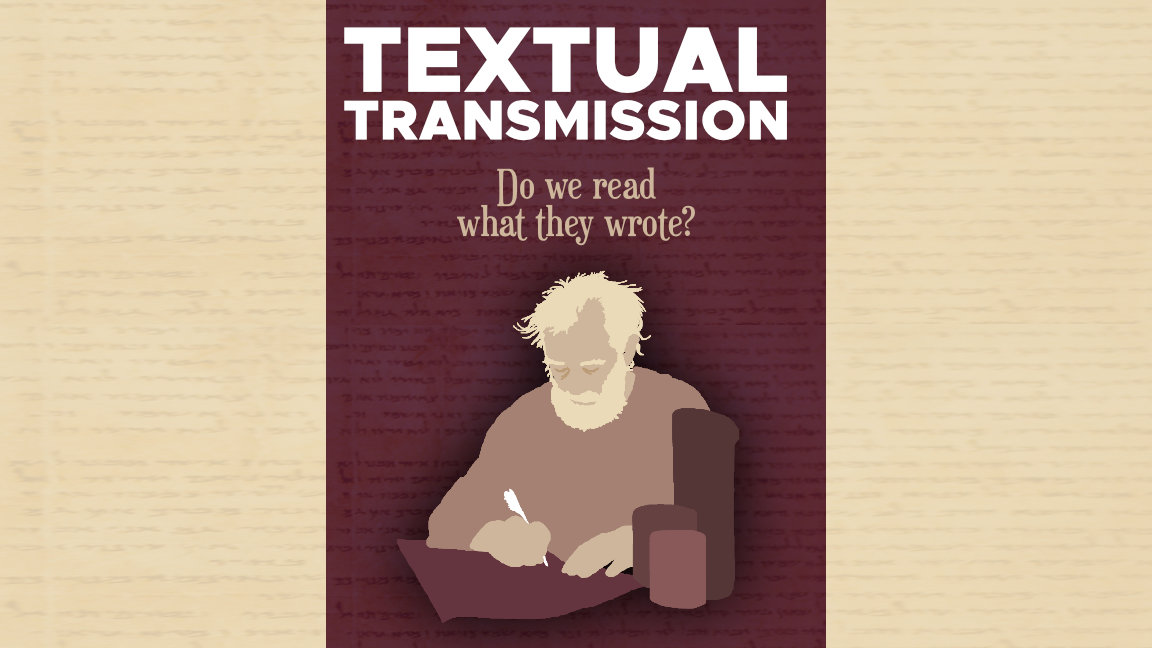 The Bibliographical Test (also called Lower Criticism or Textual Criticism) asks if the manuscripts from the first-century were accurately transmitted to us today. In other words, were the original NT documents distorted over time, or do we read what they wrote?
The Bibliographical Test (also called Lower Criticism or Textual Criticism) asks if the manuscripts from the first-century were accurately transmitted to us today. In other words, were the original NT documents distorted over time, or do we read what they wrote?
Our modern culture has at times expressed intense skepticism over the transmission of the NT. As recently as 2015, Kurt Eichenwald wrote,
No television preacher has ever read the Bible. Neither has any evangelical politician. Neither has the pope. Neither have I. And neither have you. At best, we’ve all read a bad translation—a translation of translations of translations of hand-copied copies of copies of copies of copies, and on and on, hundreds of times.[1]
Leading textual critic Bart Ehrman famously estimated that there are roughly 400,000 variants[2] in the New Testament.[3] He writes, “There are more variations among our manuscripts than there are words in the New Testament.”[4] Later, he adds, “It would be wrong… to say-as people sometimes do that the changes in our text have no real bearing on what the texts mean or on the theological conclusions that one draws from them.”[5]
These statements (from an eminent NT textual critic) seem quite intimidating! But like a mirage in the desert, these figures look different the closer we look at them. Ehrman’s statistic is numerically correct, but it lacks crucial context. For instance, imagine if I told you that I saw your wife kissing a man in bed this week. Surely, you’d be heartbroken! But what if your wife told you that she was actually visiting her dying elderly father? Furthermore, what if she was kissing him on the cheek while he lay in his hospital bed? These details would change the picture from an act of infidelity to an act of empathy.
In the same way, Ehrman’s fails to give crucial context to his claims above, skewing the overall picture. Indeed, as we will see, a more careful assessment reveals that the NT is, in fact, the most reliably transmitted document from antiquity.
The NT documents have far more manuscripts
Regarding these manuscripts, textual critic Daniel Wallace writes, “Many of these are fragmentary, of course, especially the older ones, but the average Greek New Testament manuscript is well over 400 pages long. Altogether, there are more than 2.5 million pages of texts.”[6]
In comparison with the average Greek author, we have roughly a thousand times as many NT copies. As Komoszewski, Sawyer, and Wallace note, “If the average-sized manuscript were two and one half inches thick, all the copies of the works of an average Greek author would stack up four feet high, while the copies of the New Testament would stack up to over a mile high! This is indeed an embarrassment of riches.”[7]
Indeed, two eminent NT textual critics stated that in contrast to the Greco-Roman literature, the “textual critic of the New Testament is embarrassed by the wealth of material.”[8] Guess who wrote this? Bruce Metzger and Bart Ehrman!
The NT documents have far earlier manuscripts
Full New Testaments. We currently possess sixty New Testaments that date from before the time of the printing press.[9]
(AD 325-350) Complete (or Nearly Complete) New Testaments. We have two nearly complete New Testaments by the fourth century: Codex Vaticanus and Codex Sinaiticus.
Codex Vaticanus (AD 325-350) was buried in the Vatican library in Rome for centuries before it was discovered.[10] It contains almost the entire Bible in one manuscript—both Old and New Testaments.
Codex Sinaiticus (AD 350) was discovered in the St. Catherine Monastery of Mount Sinai by biblical scholar Constantin von Tischendorf (a sort of Indiana Jones of the 19th century). Allegedly, in 1844, Tischendorf rescued this manuscript from a trashcan in the monastery that contained vellum leaves that were about to be burned. In a subsequent visit in 1859, Tischendorf was given more manuscripts that completed this discovery. All in all, Codex Sinaiticus contains almost the entire NT and half of the OT.
These two versions are sometimes called the “Neutral Text” against which the other manuscript families are compared.[11]
(AD 200) Bodmer Papyrus. P66 dates to around AD 200, and it contains an almost complete copy of John, Jude, 1 Peter, and 2 Peter. P75 dates “to the late second century,”[12] and it contains most of Luke and most of John.
(AD 175) Chester Beatty Papyri (P45) dates to “the late second century.”[13] These papyri contain parts of the four Gospels, Acts, most of Paul’s epistles, Hebrews, and the book of Revelation.[14]
(AD 125) Earliest Manuscript (P52). The John Rylands fragment is an excerpt from John 18:31-33, 37-38, which was found in the John Rylands Library in 1934. It was transported from a coffin in Egypt. It is dates to AD 125! This fragment is only 3 inches in diameter, but it shows that John was written before this time. Other manuscripts come close to the antiquity of this fragment of the gospel of John, as we see below:
The NT documents have far more citations
Historians refer to the early Christian leaders, thinkers, and writers as the Church Fathers. We have many volumes from these men that begin in the late first-century AD and extend throughout the centuries. In their writings, the Church Fathers cite the NT countless times.
Two authoritative scholars in the field write, “So extensive are these citations [from the Church fathers] that if all other sources for our knowledge of the text of the New Testament were destroyed, they would be sufficient alone for the reconstruction of practically the entire New Testament.”[15] Again, guess who wrote this statement? Bruce Metzger… and his colleague Bart Ehrman!
The NT documents have a wide geographical distribution
Our manuscripts mostly come from outside of Israel (e.g. Egypt, Italy, Turkey, Greece, etc.). This means that we possess multiple, independent manuscript families geographically spread across the ancient Roman Empire. This authenticates these documents, because it shows that the corruption was not early, and there was no way for a controlling faction to eliminate readings.
By comparison, Uthman (the third caliph of Islam in the 7th century AD) burned alternate copies of the Qur’an so that there wouldn’t be any variants! This eliminates one problem, but creates another: How do we know that Uthman burned the accurate (or inaccurate) manuscripts? The spread of the NT documents had nothing even comparable to such an action: No central authority could or would have recalled and edited texts like this.[16]
Consequently, the NT is extremely well-preserved
Only one percent of the NT is disputed. The United Bible Society (UBS4) contains “variants affecting over 1,500 words out of a total of 138,020, or only about 1 percent.”[17]
We aren’t missing NT verses, but need to sift through the variants. The idea that one percent of the NT is disputed can be slightly misleading. This doesn’t mean that we have 99% of the original autographs. Instead, we more likely have 105% of the original autographs. That is, the original writing is in our manuscripts, and textual critics need to discern which reading is correct.[18]
No important theological teachings are at stake in this one percent of disputed text. Bock and Wallace write, “Less than 1 percent of all textual variants both affect the meaning of that verse (though none affects core doctrine) and have some plausibility of authenticity.”[19]
Another scholar states that “essential Christian beliefs are not affected by textual variants in the manuscript tradition of the New Testament.”[20] Again, guess who made this statement above? Bart Ehrman!
What about the 400,000 variants in the NT manuscripts?
As we noted earlier, the 400,000 variants is not incorrect.[21] What’s terribly misleading about this statistic is that it lacks context. For instance, an old toothpaste advertising used to say, “More than 80% of dentists recommend Colgate.” This was misleading because it seemed only 20% endorsed other brands of toothpaste. In reality, 80% of dentists polled endorsed most brands of toothpaste! The statistic is true, but quite masterfully misleading. The same is true with Ehrman’s statement, unless we study the context.
First, the only reason that we have so many variants is because we have so many manuscripts. As textual critic Daniel Wallace observes, “No classical Greek or Latin text has nearly as many variants, because they don’t have nearly as many manuscripts. With virtually every new manuscript discovery, new variants are found. If there was only one copy of the New Testament in existence, it would have zero variants.”[22] But if we had only one copy, then critics would denounce the NT for having a lack of manuscripts!
The amount of NT manuscripts is a positive trade-off, not a negative one. It’s like the “problem” of being so good-looking that people are always staring at you, or the “problem” of being so popular that people always want to talk to you. These are positives—not problems. Indeed, this “criticism” of the NT document actually reveals the best evidences for NT reliability—namely, the thousands of manuscripts that support its reliable transmission.
Second, most variants are completely meaningless. In order for a variant to raise eyebrows, it needs to be both meaningful and viable. Meaningful refers to variants that change the meaning of the text, and viable refers to variants that were plausibly in the original. That is, they have good textual support. But as we have seen, only one percent of variants are both meaningful and viable. The rest are simply obvious and inconsequential. Consider some of the most common variants below:
(1) Most variants are due to spelling differences. These account for roughly 70% of all textual variants.[23] For instance, the Greek language has what is called a “moveable nu.” The Greek letter nu (or “n”) can be put at the end of a word that comes before a word that starts with a vowel. This is very similar to using “a” versus “an” in English. However, the “moveable nu” creates “absolutely no difference in meaning. It is so insignificant that most textual critics simply ignore the variants involving a movable nu when transcribing the words of a manuscript. It affects nothing.”[24]
(2) Many variants are due to word order. In English, it would change the meaning of sentence a great deal if we rearranged the words. For instance, compare these two sentences below:
“John ate the bear.”
“The bear ate John.”
In Greek, the order of the words doesn’t change the meaning. Greek is an inflected language. This means that the nouns and verbs have specific suffixes that show which words are the subject (nominative) and which are the direct object (accusative). This means that the arrangement of the words can change, but meaning remains identical. Indeed, the only change is emphasis—not meaning. Many of our variants fall into this category as well.
(3) Almost all variants are very short. In fact, only two variants are longer than two verses! Blomberg writes, “The only disputed passages involving more than two verses in length are… Mark 16:9-20 and John 7:53-8:11.”[25]
Third, variations are not contradictions. Imagine if your wife said, “I love you,” and then she said, “You are loved by me.” And, finally, she said, “I adore you.” Would you tell her to stop contradicting herself, or to stop repeating herself? In the Greek language, there are 16 different ways to state the simple phrase: “Jesus loves John.”[26]
Finally, if the NT text is so unknowable, then how could anyone know this? This sort of skepticism is self-refuting. Ehrman’s assertion is how uncertain the text is, but then, he claims to know what was and was not in the original text. This is utterly self-defeating. Ehrman repeatedly shows which passages are original, and he “demonstrates how the abundance of manuscripts and the antiquity of manuscripts, when run through the mill of text-critical methodology, allow us to know with a very high level of probability what the evangelists and other New Testament authors wrote.”[27]
Conclusion
Most of the variations that Ehrman cites in his statistic are simply word order, spelling differences, or other insignificant variants, which do nothing to change the meaning or message of the original author. If we deny the NT on these grounds, then we would need to deny all ancient documents, and this one decision would effectively send us back to the Dark Ages in our knowledge of ancient history.
This is why another expert in textual criticism has this to say about the accuracy of the transmission of the NT. At this point, I’m sure you can predict who said this… (HINT: His name rhymes with “Smart Chairman.”)
To be sure, of all the hundreds of thousands of textual changes found among our manuscripts, most of them are completely insignificant, immaterial, of no real importance for anything other than showing that scribes could not spell or keep focused any better than the rest of us.[28]
This oldest form of the text is no doubt closely (very closely) related to what the author originally wrote, and so it is the basis for our interpretation of his teaching.[29]
Once again, Bart Ehrman wrote this! If anyone thinks that NT textual variants lead to a corrupt text, then they need to explain why critic Bart Ehrman would deny such an idea. Furthermore, Ehrman’s mentor at Princeton was Dr. Bruce Metzger whom Ehrman describes as a “firmly committed Christian.”[30] Why didn’t the study of textual criticism cause Metzger to lose his faith? Moreover, Dr. Michael Holmes—Metzger’s second to last student—is also a Bible-believing Christian. Why hasn’t he lost his faith? Indeed, why do so many textual critics have a strong faith in the biblical text—why is Ehrman the odd man out?
Regarding Ehrman’s skepticism, one scholar observes, “Ehrman’s skepticism is more existential than evidential. It originates in his own autobiography more than the autographs.”[31]
[1] Kurt Eichenwald, “The Bible: So Misunderstood It’s a Sin,” Newsweek, January 2015.
[2] Textual variants are counted by how they deviate from the Nestle-Aland (NA) text. Variants are not counted by how they are multiplied by the other 5,000+ manuscripts in existence. Daniel Wallace writes, “If variants were actually counted [by adding together each variant in every manuscripts], the number of variants among the Greek New Testament manuscripts would be in the tens of millions.” Elijah Hixson and Peter J. Gurry (editors), Myths and Mistakes in New Testament Textual Criticism (Downers Grove, IL: InterVarsity Press, 2019), p.xiii. This is contra apologist Neil Lightfoot, How We Got the Bible (Grand Rapids: Baker, 1963), pp.53-54. This claim is repeated in Norman Geisler, Baker Encyclopedia of Christian Apologetics (Grand Rapids: Baker, 1998), p.532.
[3] Bart D. Ehrman, Misquoting Jesus: the Story behind Who Changed the Bible and Why (New York: HarperSanFrancisco, 2005), p.89.
[4] Bart D. Ehrman, Misquoting Jesus: the Story behind Who Changed the Bible and Why (New York: HarperSanFrancisco, 2005), p.90.
[5] Bart Ehrman, Misquoting Jesus (San Francisco: Harper, 2005), p.208.
[6] Bart Ehrman & Daniel B. Wallace, The Reliability of the New Testament (Minneapolis: Fortress, 2011), p.33.
[7] J. Ed Komoszewski, M. James Sawyer, and Daniel B. Wallace, Reinventing Jesus (Grand Rapids, MI: Kregel, 2006), p.82.
[8] Bruce Metzger & Bart Ehrman, The Text of the New Testament (Oxford, 2005), p.51.
[9] Timothy N. Mitchell. Elijah Hixson and Peter J. Gurry (editors), Myths and Mistakes in New Testament Textual Criticism (Downers Grove, IL: InterVarsity Press, 2019), p.63.
[10] R. Laird Harris, Inspiration and Canonicity of the Scriptures (Greenville, SC, 1995), p.65.
[11] R. Laird Harris, Inspiration and Canonicity of the Scriptures (Greenville, SC, 1995), p.70.
[12] Craig A. Evans, Fabricating Jesus (Downers Grove, IL: InterVarsity Press, 2006), p.32.
[13] Craig A. Evans, Fabricating Jesus (Downers Grove, IL: InterVarsity Press, 2006), p.32.
[14] R. Laird Harris, Inspiration and Canonicity of the Scriptures (Greenville, SC, 1995), p.72.
[15] Bruce Metzger & Bart Ehrman, The Text of the New Testament (Oxford, 2005), p.126.
[16] See Nabeel Qureshi, No God but One: Allah or Jesus? (Grand Rapids, MI: Zondervan, 2016), pp.119-120.
[17] Elijah Hixson and Peter J. Gurry (editors), Myths and Mistakes in New Testament Textual Criticism (Downers Grove, IL: InterVarsity Press, 2019), p.12.
[18] J. Ed Komoszewski, M. James Sawyer, and Daniel B. Wallace, Reinventing Jesus (Grand Rapids, MI: Kregel, 2006), p.109.
[19] Emphasis mine. Darrell L. Bock and Daniel B. Wallace, Dethroning Jesus: Exposing Popular Culture’s Quest to Unseat the Biblical Christ (Nashville, TN: Thomas Nelson, 2007), p.71.
[20] Bart D. Ehrman, Misquoting Jesus: the Story behind Who Changed the Bible and Why (New York: HarperSanFrancisco, 2005), p.252.
[21] Peter J. Gurry argues for 500,000 non-spelling variants. See Elijah Hixson and Peter J. Gurry (editors), Myths and Mistakes in New Testament Textual Criticism (Downers Grove, IL: InterVarsity Press, 2019), p.9.
[22] Bart Ehrman & Daniel B. Wallace, The Reliability of the New Testament (Minneapolis: Fortress, 2011), p.33.
[23] Daniel Wallace, In Defense of the Bible (Nashville, TN: B&H Publishing, 2013), 152.
[24] J. Ed Komoszewski, M. James Sawyer, and Daniel B. Wallace, Reinventing Jesus (Grand Rapids, MI: Kregel, 2006), p.56.
[25] Craig Blomberg, Can We Still Believe the Bible? (Grand Rapids, MI: Brazos Press, 2014), p.18.
[26] Darrell L. Bock and Daniel B. Wallace, Dethroning Jesus: Exposing Popular Culture’s Quest to Unseat the Biblical Christ (Nashville, TN: Thomas Nelson, 2007), p.56.
[27] Mark D. Roberts, Can We Trust the Gospels? (Wheaton, IL: Crossway, 2007), p.37.
[28] Emphasis mine. Bart D. Ehrman, Misquoting Jesus: the Story behind Who Changed the Bible and Why (New York: HarperSanFrancisco, 2005), p.207.
[29] Emphasis mine. Bart D. Ehrman, Misquoting Jesus: the Story behind Who Changed the Bible and Why (New York: HarperSanFrancisco, 2005), p.62.
[30] Bart D. Ehrman, Misquoting Jesus: the Story behind Who Changed the Bible and Why (New York: HarperSanFrancisco, 2005), p.252.
[31] Al Kresta, Dangers to the Faith: Recognizing Catholicism’s 21st-Century Opponents (Huntington, Indiana: Sunday Visitor, 2013), p.152.

